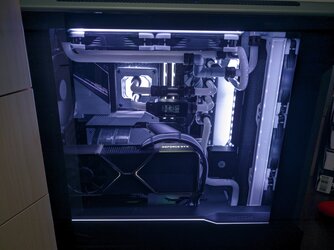Hello there, I'm new to this forum and I recently built my first desktop computer (always used high level laptops before). Below are my complete specs:
Case: Phanteks Evolv X
MoBo: Aorus Z690 Master
CPU: I7 12700K
Ram: G.Skill Trident Z5 5600Mhz CL36 2x16GB (DDR5 Rams of course)
PSU: Seasonic TX-1000
GPU: RTX 3080Ti FE
Storage: Samsung 980 Pro 2TB + Samsung 960 Evo 2TB
Cooling: custom loop featuring a 420mm and a 280mm rads (in parallel). Only CPU has been watercooled at the moment, i'll watercool also the GPU when i have decided if i want to sell it and buy something else or not. Oh, I used the Arctic MX5 between CPU IHS and Waterblock. Also, every fan in the case is a 140mm Noctua IPPC 3000.
The fact is running cinebench ON STOCK settings I'm having temps like 73/75 degrees on a beefy custom loop (attaching photo so you can clearly see it). I want to understand if they are normal temperatures or not, since I'm not getting it. Some reviewers talks about 80 degs temps on heavily OCed 12700k, but if i set everything to 5GHz (without touching Vcore offset), i reach 85/86 degrees. Ok, the silicon lottery is a thing, but it seems a bit strange. Someone else talk about even 95 degrees on a Noctua NH-D15. So, I'm a bit confused. Can you please clarify me?
Case: Phanteks Evolv X
MoBo: Aorus Z690 Master
CPU: I7 12700K
Ram: G.Skill Trident Z5 5600Mhz CL36 2x16GB (DDR5 Rams of course)
PSU: Seasonic TX-1000
GPU: RTX 3080Ti FE
Storage: Samsung 980 Pro 2TB + Samsung 960 Evo 2TB
Cooling: custom loop featuring a 420mm and a 280mm rads (in parallel). Only CPU has been watercooled at the moment, i'll watercool also the GPU when i have decided if i want to sell it and buy something else or not. Oh, I used the Arctic MX5 between CPU IHS and Waterblock. Also, every fan in the case is a 140mm Noctua IPPC 3000.
The fact is running cinebench ON STOCK settings I'm having temps like 73/75 degrees on a beefy custom loop (attaching photo so you can clearly see it). I want to understand if they are normal temperatures or not, since I'm not getting it. Some reviewers talks about 80 degs temps on heavily OCed 12700k, but if i set everything to 5GHz (without touching Vcore offset), i reach 85/86 degrees. Ok, the silicon lottery is a thing, but it seems a bit strange. Someone else talk about even 95 degrees on a Noctua NH-D15. So, I'm a bit confused. Can you please clarify me?
Attachments
Last edited:
